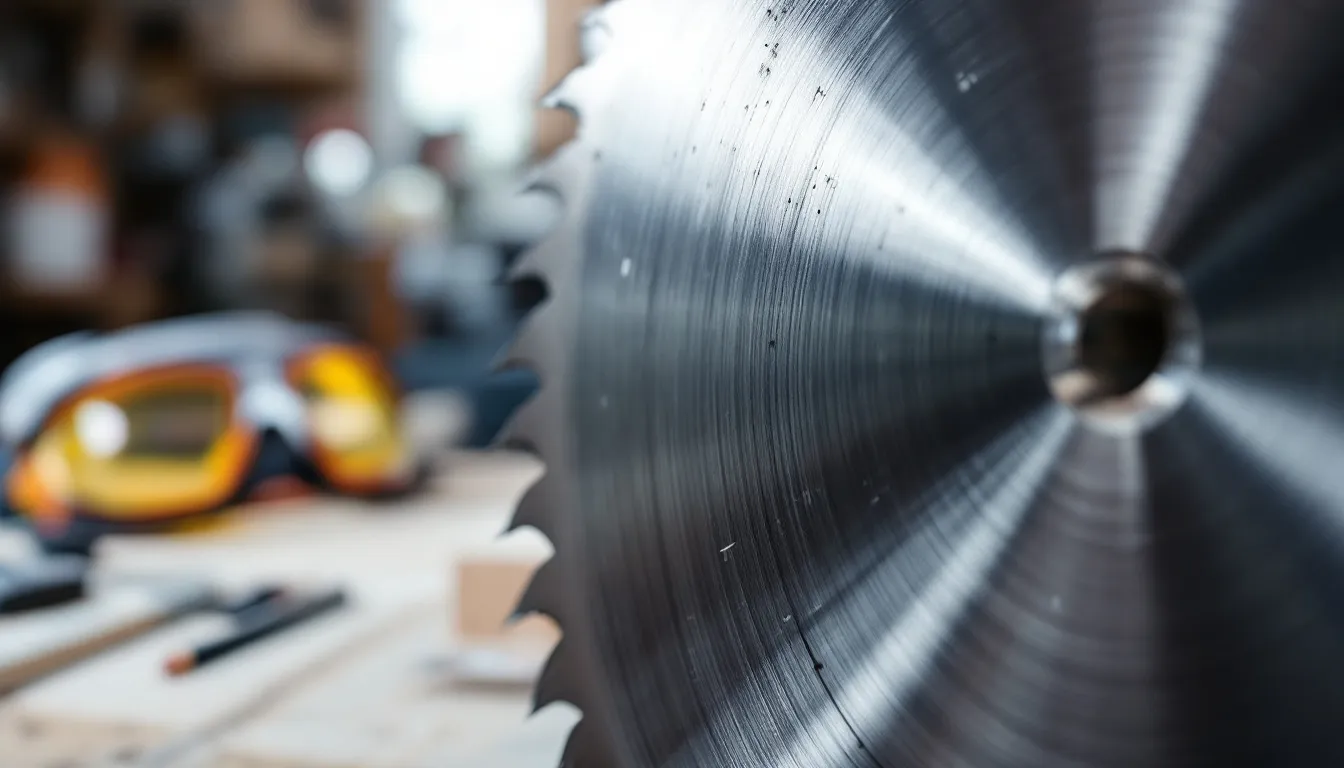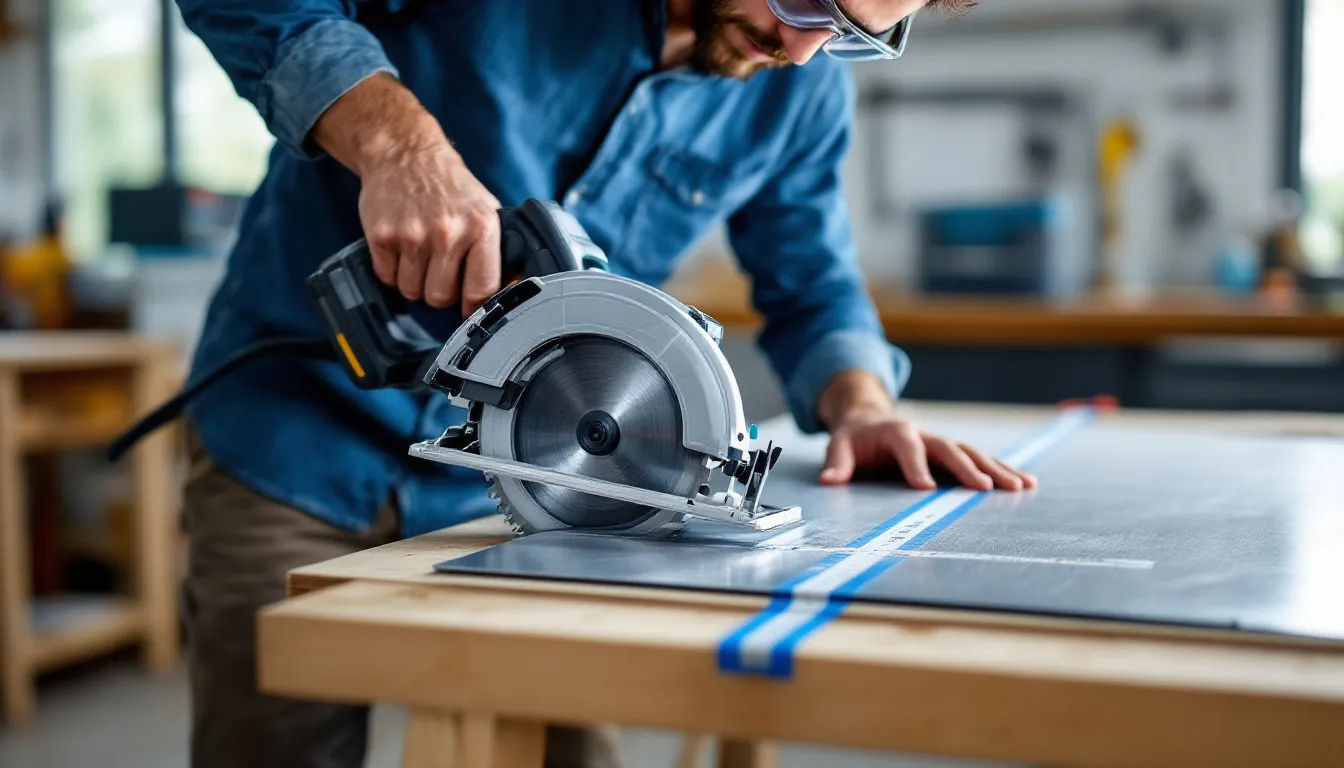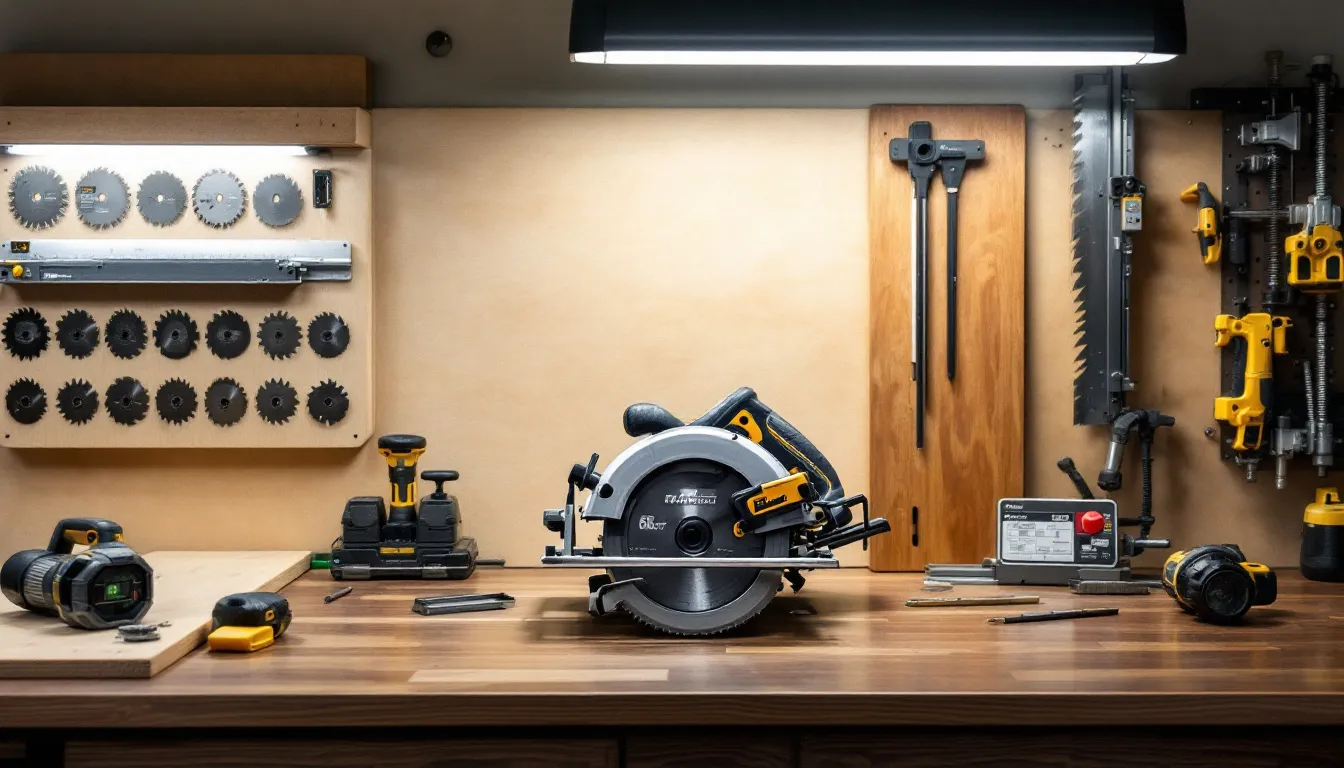Best Practices for Cutting Aluminum with Circular Saw
Naturally, suitable attire is encouraged!
Cutting aluminum with a circular saw is possible and can be done safely with the right tools and techniques. To cut aluminum effectively, it is crucial to use the appropriate types of blades, such as non-ferrous metal cutting blades, and ensure the workpiece is securely fastened using clamps to prevent movement. Whether you’re a DIY enthusiast or a professional, knowing how to choose the correct blade for cutting aluminum with a circular saw, prepare your work area, and follow safety protocols is essential. This guide covers everything you need to know to achieve clean and precise cuts in aluminum when cutting aluminum with a circular saw.
Key Takeaways
-
Choosing the appropriate blade, such as carbide tipped or metal cutting blades, is essential for achieving clean cuts in aluminum and prolonging tool life.
-
Proper workplace preparation, including securing aluminum sheets and wearing appropriate safety gear, significantly enhances cutting efficiency and reduces injury risks.
-
Implementing effective cutting techniques, using lubricants, and managing aluminum chips are crucial for achieving smooth cuts and maintaining a safe work environment.
Choosing the Right Circular Saw Blade

Selecting the right circular saw blade is crucial for clean and efficient cuts in aluminum. Unlike wood, aluminum demands blades designed for its properties. Incorrect blades can cause poor cuts, ripping, and saw damage. Metal cutting and carbide-tipped blades are ideal for aluminum, each offering unique benefits. Using a fine blade with many teeth ensures precise cuts and extends tool life.
As a non-ferrous metal, aluminum requires specific blades for effective cutting. Metal cutting blades or wood blades with carbide tips are ideal. The right blade reduces material grabbing and boosts cutting efficiency. Understanding these differences aids in making informed choices.
Metal Cutting Blades
Metal blades are designed specifically for non-ferrous metals like aluminum. These blades usually feature a fine tooth count, which is essential for achieving clean and precise cuts. A high-speed steel blade can maintain sharpness at high speeds, making it suitable for cutting softer metals such as aluminum. Using the right metal cutting blade prevents the material from ripping and the blade from dulling.
For handheld circular saws, choosing a metal cutting blade designed for non-ferrous metals ensures cleaner cuts and reduces material deformation. Sharp blades prevent material grabbing and create smooth edges on aluminum plates.
Carbide Tipped Blades
Carbide tipped blades (TCT) are renowned for their durability and efficiency in cutting aluminum. Ideal for heavier projects like cutting tubes, pipes, or commercial windows, these carbide tip blades maintain sharpness and efficiency over time, making them a valuable investment for frequent tasks.
A carbide tipped blade designed for aluminum prevents material grabbing or tearing, ensuring cleaner cuts. Suitable for handheld circular saws and stationary tools like miter and chop saws, the right blade enhances cutting performance and achieves professional results.
Preparing Your Work Area
Proper workspace preparation is key before cutting aluminum. A clean, organized work area enhances both cutting efficiency and safety. Ensure your workspace is clutter-free and well-lit to avoid accidents and achieve precise cuts.
Prioritize safety by wearing proper gear, including safety goggles, face shields, and hearing protection. Securing aluminum sheets properly is also crucial to prevent movement and ensure accurate cuts.
Let’s delve into these aspects in more detail.
Securing Aluminum Sheets
Securing aluminum sheets is essential before cutting. Clamping the workpiece prevents movement, ensuring accurate cuts and reducing injury risk. Multiple clamps or a vise are the safest methods, with standard woodworking clamps, vises, or a routing table being suitable tools.
Securing the aluminum piece properly also prevents the cut-off piece from being dragged towards the blade, reducing injury risk. Clamping a piece of wood to the side of the cut-off piece helps ensure a safer cutting process.
Safety Gear
Wearing the appropriate safety gear is essential when cutting aluminum. Safety goggles protect your eyes from metal shavings, while a full face shield can provide additional protection for your face and neck. It’s also important to wear fitted clothing and avoid loose gloves or rings that could get caught in the saw. Hearing protection is another critical aspect, as the noise from cutting metal can be damaging over time.
Keeping a safe distance from the blade, with fingers at least six inches away while feeding material, is crucial for preventing accidents. Wearing the correct safety gear and following protocols significantly reduces injury risk while cutting aluminum.
Cutting Techniques for Aluminum

Mastering proper cutting techniques ensures smooth and clean cuts in aluminum. A fine-toothed blade aids in achieving cleaner cuts. Applying lubricants reduces chip welding and dissipates heat. Adjusting feed rate and spindle speed also prevents aluminum chips from welding onto the blade.
Selecting the correct cutting technique, like climb cutting, enhances chip removal and reduces welding likelihood. Next, we will explore the use of cutting oil and adjusting blade speed.
Using Cutting Oil
Cutting oil reduces friction and prevents blade clogging when cutting aluminum. Wax sticks are recommended lubricants. Applying cutting oil prevents chip welding, allows for smoother cuts, and dissipates heat.
Mist or coolant systems directed at the cutting zone help clear aluminum chips effectively. If unsure about the best lubricant, reviewing the manufacturer’s recommendations is advisable.
Adjusting Blade Speed
Setting the correct blade speed based on aluminum thickness is crucial for smooth cuts. A slower blade speed helps reduce overheating and blade wear, particularly with thicker sections.
Adjusting blade speed properly ensures clean cuts without damaging the material or blade.
Managing Aluminum Chips
Managing aluminum chips is vital for a clean and safe workspace. Regular collection prevents clutter and reduces hazards. A suitable receptacle near the cutting area streamlines collection. A vacuum system can reduce chip spread but may require constant attention.
Effective chip management enhances safety and improves cutting efficiency. Next, we will look at methods for collecting aluminum chips and preventing chip welding.
Collecting Aluminum Chips
Metal tipping containers near machining areas streamline aluminum chip collection for processing or disposal. Mesh bags or containers are also effective, allowing easier cleanup. Regularly emptying containers prevents overflow and ensures a safe workspace.
Proper disposal of aluminum chips following local regulations avoids environmental impact. A clean workspace through efficient chip collection enhances safety and cutting efficiency.
Preventing Chip Welding
Lubricants like cutting oil or wax keep the blade cool and clean during aluminum cutting. Products like WD-40 prevent aluminum from sticking to the blade effectively.
Using chip-resistant coatings and proper lubrication during cutting prevents aluminum chips from welding onto the blade.
Maintaining Your Circular Saw and Blades

Regular maintenance of your circular saw and blades ensures optimal performance and longevity. Clean and inspect blades for wear or damage to maintain efficiency. Yearly saw evaluations identify necessary maintenance and replacements. Sharp blades enhance performance and reduce strain.
Knowing when to sharpen blades extends their lifespan and saves money on replacements. Next, we will explore cleaning, inspecting, and sharpening blades.
Cleaning and Inspecting Blades
Sharp circular saw blades are vital for clean cuts and preventing workpiece damage. Dull blades cause rough cuts, making wear inspections essential. Regularly check for visible wear, like chipped teeth, to evaluate cutting ability.
Establishing a routine for inspecting and maintaining blades prolongs their life and improves cutting performance. Regular cleaning and inspections keep blades in optimal condition for cutting aluminum.
Sharpening Blades
Maintaining your circular saw blades is crucial for longevity and performance. Remove blades from the saw for cleaning and inspection, using a soft brush or cloth to remove debris and check for wear. Sharp blades enhance cutting performance and reduce saw strain.
Changes in cutting performance indicate when blades need sharpening. Knowing when to sharpen extends blade life and saves on replacements. Professional sharpening services can help maintain blades effectively.
Common Mistakes to Avoid
Avoiding common mistakes ensures safety and optimal results when cutting aluminum. Ignoring safety protocols can lead to serious accidents. Wearing fire-retardant clothing protects against potential hazards.
Using incorrect blades is another common mistake. Wood blades for aluminum result in poor cut quality and risk aluminum binding to the blade. Next, we delve into these mistakes in more detail.
Using Incorrect Blades
Inappropriate blades cause material tearing and poor results. Wood blades for aluminum can cause sticking, leading to rough cuts and potential damage. Use blades specifically designed for aluminum, like metal cutting or carbide tipped blades.
Correct tools and blades ensure cleaner cuts and reduce accident risk. Always check blade specifications to confirm suitability for non-ferrous metal cutting, avoiding incorrect blade use.
Ignoring Safety Protocols
Adhering to safety protocols significantly reduces accident risk when cutting aluminum. Proper workspace preparation, like securing aluminum sheets with clamps, prevents movement and accidents. Wearing safety glasses, gloves, and hearing protection is essential for protection.
Ignoring these protocols can cause serious injuries. Common mistakes like using inappropriate blades compromise safety and lead to accidents.
Always follow safety guidelines, wear safety goggles, and ensure your workspace is prepared to avoid these risks.
Recommended Tools for Cutting Aluminum

The right tools for cutting aluminum ensure clean cuts and prolong equipment life. Handheld circular saws, miter saws, and table saws suit various cuts and project sizes. High-quality tools and blades designed for aluminum offer better performance and fewer maintenance issues.
Top-quality blades, like tungsten carbide-tipped blades, offer durability and efficiency, reducing the need for frequent replacements and enhancing cutting precision.
Next, we explore the benefits of different saw types for cutting aluminum.
Handheld Circular Saws
Handheld circular saws are favored for their portability and versatility in aluminum cutting projects. The Bosch GKS18V-25GCB14 is highly regarded for accuracy and efficiency, making it a top choice for professionals and DIY enthusiasts. The Skil 5280-01 offers affordability and pro-grade performance for those on a budget, especially when using a handheld circular saw.
Using a routing table enhances stability while cutting aluminum sheets, providing a controlled environment. Handheld circular saws with the correct blade achieve clean, precise cuts, making them excellent for various aluminum cutting projects.
Miter Saws
Miter saws can achieve precise cuts in aluminum, especially when fitted with a specialized blade for non-ferrous metals. The accuracy of miter saws makes them ideal for creating intricate aluminum joints and fittings, which is essential for framing and trim work.
Equipping your miter saw with a proper non-ferrous cutting blade ensures exceptional precision for aluminum cuts. Miter saws are particularly effective for making precise angled cuts in aluminum, enhancing the quality and accuracy of your projects.
Table Saws
Table saws are advantageous for cutting larger aluminum pieces, providing stability and accuracy during the process. They offer a stable cutting surface, making them ideal for larger aluminum sheets that require straight, consistent cuts. Utilizing a table saw with a suitable blade can enhance cutting efficiency and accuracy when working with thick aluminum materials.
Table saws can efficiently handle larger aluminum plate sheets, allowing for clean and straight cuts. For those working on extensive aluminum projects, a table saw is an invaluable tool that ensures precision and stability.
Summary
Cutting aluminum with a circular saw requires careful selection of the right tools and blades, proper workspace preparation, adherence to safety protocols, and effective cutting techniques. By choosing the correct circular saw blade, securing your work area, using appropriate lubricants, and maintaining your equipment, you can achieve clean and precise cuts while minimizing risks. Remember, investing in high-quality tools and following best practices will not only enhance your cutting performance but also ensure safety and efficiency in all your aluminum cutting projects.
Frequently Asked Questions
What type of blade should I use for cutting aluminum with a circular saw?
For cutting aluminum with a circular saw, you should use a metal cutting blade or a wood blade with carbide tips, as they are designed to handle non-ferrous metals and ensure clean cuts.
How can I prevent aluminum chips from sticking to my saw blade?
To prevent aluminum chips from sticking to your saw blade, apply a lubricant such as cutting oil or wax, and regularly adjust the feed rate and spindle speed. This will significantly reduce the risk of chip welding.
What safety gear is necessary when cutting aluminum?
Wearing safety goggles, a full face shield, hearing protection, and fitted clothing is essential when cutting aluminum to protect against metal shavings and loud noise. Prioritizing these items will ensure your safety during the task.
How do I maintain my circular saw and blades for optimal performance?
To ensure optimal performance of your circular saw and blades, regularly clean and inspect them for wear or damage, and sharpen as needed. Establishing a routine maintenance schedule will greatly enhance their longevity and efficiency.
What are the benefits of using a table saw for cutting aluminum?
Using a table saw for cutting aluminum offers enhanced stability and accuracy, making it ideal for larger sheets that require straight cuts. This efficiency is crucial for achieving professional results in extensive aluminum projects.

